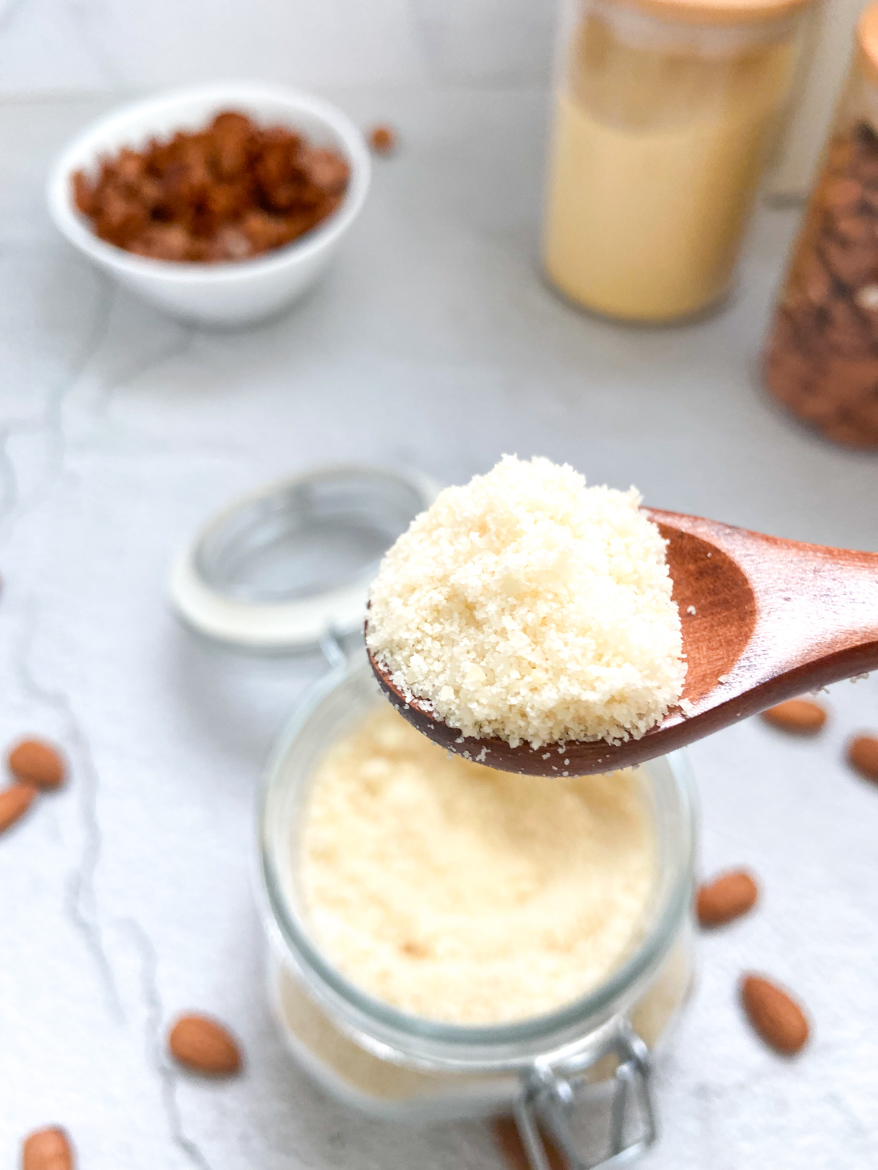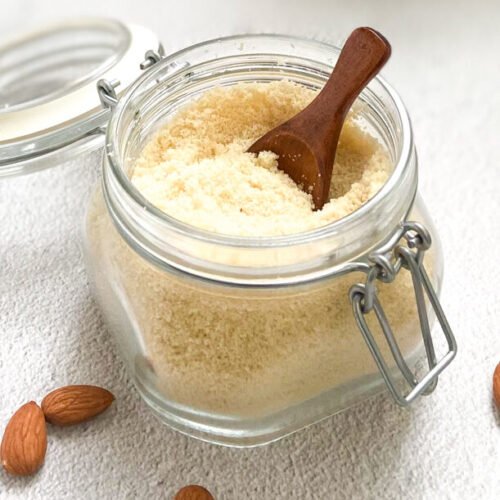Wondering how to make homemade almond flour? It’s very easy! With only a few simple steps, you can have homemade almond flour that you can use in gluten-free baking or add to baked goods for an extra moist texture.

Homemade almond flour is a fantastic ingredient to have on hand. Like coconut flour, it’s gluten-free, grain-free, low-carb, and Paleo. However, the uses of almond flour do not stop there, as it can be used in many recipes. I love mixing it with other flours to give baked goods an extra moist texture.
Almond flour can be very overpriced sometimes. Since I have learned how to make homemade almond flour, I’ve been using my fresh it in many recipes. From start to finish, the whole process takes less than a minute. Keep reading to find my method on how to make homemade almond flour.
Table of Contents
INGREDIENTS FOR THE FLOUR
Before we talk about how to make homemade almond flour, let’s first talk about the ingredients – almonds!
As you already know, almonds come in many types and shapes. Raw, unsalted, roasted, salted, flaked, silvered and these are just a few examples. But when it comes to making homemade almond flour, I do recommend these types of almonds below:
- Raw unsalted almonds with skin: These are raw almonds that are packaged after the hard shell has been removed. They are ideal for making homemade whole almond flour(almond meal).
- Blanched almonds: These are raw almonds without the skin. Blanched almonds produce a smooth and delicate texture of the flour. Blanched almonds are a bit more expensive because of the work required to remove the skin from each almond. However, you can peel almonds at home with a few easy septs.
- Flaked or silvered almonds: These almonds are the same as blanched almonds. The only difference is that they have been shaved into thin flakes or cut into tiny strips (silvers).
You can easily tell the difference between whole almond flour (almonds with the skin on) and blanched almond flour (without skin) just by looking at the color of the flour. Blanched almond flour has a lighter color, and whole almond flour (almond meal) has a darker color with brown pieces of almond skin. Therefore, peeled almonds will produce a finer and more delicate texture than almonds with the skin.


Since almond meal and almond flour have different textures, depending on your baking project or task, what you use can make a difference in how your food turns out.
For example, if you’re making delicate macarons or a light, airy cake, you’ll want to reach for more fine almond flour. If your recipe is more forgiving, like quick bread or breaded meat, it likely won’t matter much and you can use either one.

HOW TO MAKE HOMEMADE ALMOND FLOUR
You can make your homemade almond flour with a few easy septs! Here’s what you need to do:
- Start with 1 cup of almonds.
- Add the almonds to a high-powered blender and process until they are finer than bread crumbs, about 10 seconds. Then stir to loosen any clumps or large chunks and blitz for a few more seconds. However, be careful not to process the almonds too long, or they will turn into almond butter!
- Lastly, sift the homemade almond flour, and if you still have some large pieces left, beat the leftovers again.


CAN I USE ALMOND FLOUR IN PLACE OF NORMAL FLOUR
Most people wonder how I can make a recipe healthier by using almond flour instead of all-purpose flour. However, the answer to this question is yes and no. It all depends on the recipe itself and may require you to test the recipe a few times.
In general, you can use a 1:1 ratio, especially if the recipe uses eggs as a binder. As almond flour typically requires more eggs (needs more binder), you may need to increase the number of eggs (aka binder) used in the recipe. If you’re new to baking with almond flour, I would suggest first working from a recipe and getting used to the texture of the flour.
Also, bear in mind that almond flour is a high-fat flour and therefore contains a lot of moisture. If you would like to swap all-purpose flour for homemade almond flour, the baked goods will look and feel greasy. To avoid this, you will need to adjust the amount of almond flour, liquids, and fats used in a recipe. For the best results, instead, swap all-purpose flour for almond flour, I recommend using almond flour more as an add-in to a recipe vs. the central component of the recipe.

WHAT IS A GOOD SUBSTITUTE FOR ALMOND FLOUR
Due to its high-fat content, I recommend replacing the almond flour with another nut flour (walnut, hazelnut, sunflower seed, or macadamia nut). Although it still depends on the recipe. Most of the time, a 1:1 ratio should work. However, be aware that the final taste of the recipe will be different.
ALMOND FLOUR STORAGE:
If you use almond flour in baking regularly, it might be a good idea to make your homemade almond flour and store it for later use.
The best way to store homemade almond flour depends on how quickly you plan on using it. Therefore:
- If you plan on using it in a week or two, place it in an airtight glass jar, seal it tightly, and store it in the fridge.
- If you plan on using it after a week or two, place it in an airtight container, seal it tightly, and store it in the freezer for up to 6 months. When you need to use it, remove it from the freezer, let it come to room temperature, and use it as directed in the recipe.

HOW TO USE HOMEMADE ALMOND FLOUR
Once you have homemade almond flour in your hands, you’ll find plenty of ways to use it! You can make cakes, pancakes, cookies, cupcakes, and muffins or use it instead of bread crumbs.
I use homemade almond flour in my gluten-free recipes below:
- Chicken Meatballs In Marinara Sauce
- Gluten-Free Zucchini Muffins With Cashews Frosting
- Almond Flour Pancakes

How To Make Homemade Almond Flour
Equipment
- Blender
- Airtight Pot
- Sieve
Ingredients
- 1 cup raw almonds
Instructions
- Add the almonds to a high-speed blender and pulse for about 10 seconds at a time, until they have a fine texture. Stop and stir to loosen any large chunks of almonds near the base of the blender and process for a few more 10 seconds. The whole process shouldn't take more than a minute.Don't over-beat your almonds as they will start to turn into almond butter!
- Sift the flour and if there are any large chunks left over, process the rest again.
